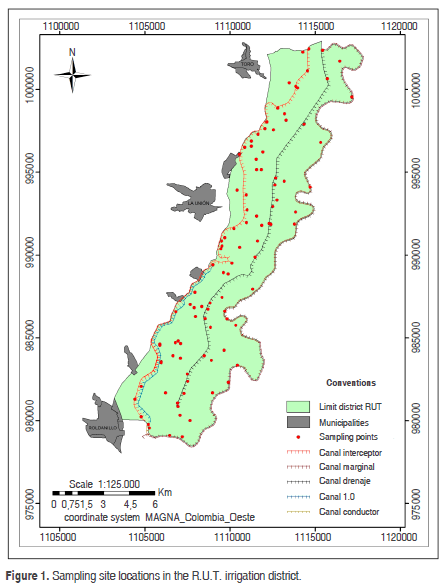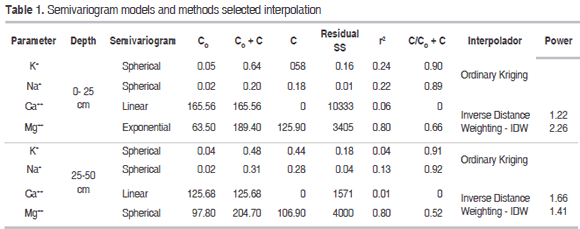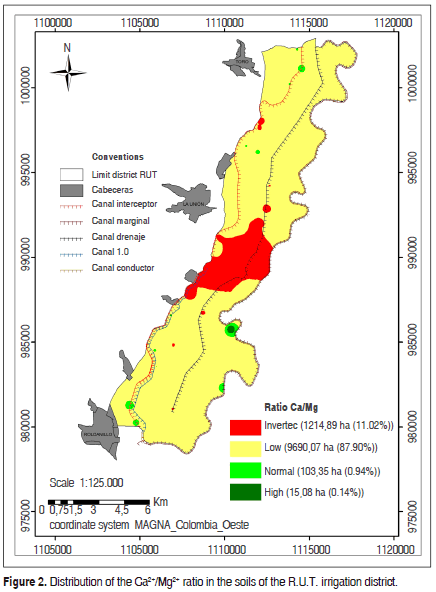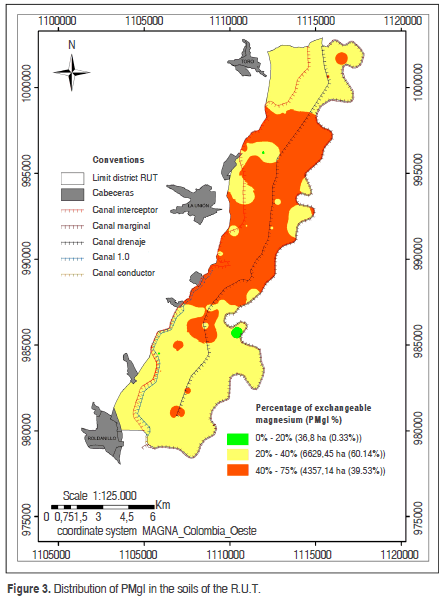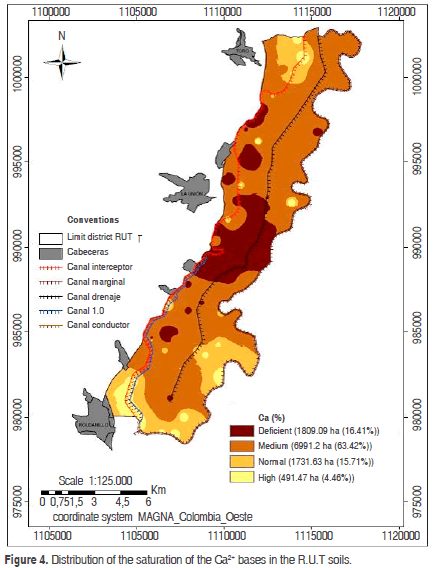Services on Demand
Journal
Article
Indicators
-
 Cited by SciELO
Cited by SciELO -
 Access statistics
Access statistics
Related links
-
 Cited by Google
Cited by Google -
 Similars in
SciELO
Similars in
SciELO -
 Similars in Google
Similars in Google
Share
Revista Facultad Nacional de Agronomía Medellín
Print version ISSN 0304-2847
Rev. Fac. Nac. Agron. Medellín vol.70 no.1 Medellín Jan./Apr. 2017
https://doi.org/10.15446/rfna.v70n1.61766
DOI: http://dx.doi.org/10.15446/rfna.v70n1.61766
Spatial distribution of the exchangeable base ratios in the soils of the R.U.T. irrigation district
Distribución espacial de las relaciones entre las bases de cambio en suelos del distrito de riego R.U.T.
Carlos José López Martínez1, Andrés Echeverri2 and Juan Carlos Menjivar Flores3
1 Facultad de Ciencias Agrícolas. Universidad Nacional de Colombia. A.A. 237, Palmira, Colombia. <cjlopez2218@gmail.com>
2 Escuela de Ingenieria de Recursos Naturales y del Ambiente. Universidad del Valle. A.A. 25360, Cali, Colombia
3 Facultad de Ciencias Agrícolas. Universidad Nacional de Colombia. A.A. 237, Palmira, Colombia
Received: June 8, 2016; Accepted: August 29, 2016
This work is licensed under a Creative Commons Attribution-NonCommercial-NoDerivatives 4.0 International License.

ABSTRACT
One of the more important agricultural production centers in Colombia is the R.U.T. Irrigation District, located in the Valle de Cauca. This study evaluated the spatial distribution of ratios of Ca2+, Mg2+, Na+ and K+, along with the percentage of saturation of these bases in the cation exchange capacity. 100 samples were taken at two depths to determine the EC, pH, Ca2+, Mg2+, Na+ and K+. The interpolations were made using the Geostatistical Analyst extension of ArcGis 10.3.1. The best fit semivariogram model was used, obtaining a raster surface with values of each chemical property, with which the plans were generated. The central area of the (La Union) irrigation district was more affected, with percentages of exchangeable magnesium between 40% and 75%, an inverted Ca2+/Mg2+ ratio, and a low calcium saturation percentage. The ratios were high for Mg2+/K+, normal for K+/Mg2+, high for Ca2+/K+, and broad for (Ca2+ + Mg2+)/K+, indicating a probable potassium deficiency that affected fertility. An ionic imbalance in the exchange complex was evident in the main bases of change, which may indicate degradation processes for fertility.
Key words: Soil, Fertility, Nutrients, Percentage of saturation.
RESUMEN
Uno de los más importantes centros productivos agrícolas de Colombia es el Distrito de Riego R.U.T. localizado en el Valle del Cauca. El presente estudio evaluó la distribución espacial de las relaciones entre Ca2+, Mg2+, Na+ y K+, además del porcentaje de saturación de estas bases en la capacidad de intercambio de cationes. Se tomaron 100 muestras a dos profundidades, a las cuales se les determinó la CE, pH, Ca2+, Mg2+, Na+ y K+. Las interpolaciones se realizaron mediante el uso de la extensión Geostatistical Analyst del ArcGis 10.3.1 Se utilizó el modelo de semivariograma de mejor ajuste, obteniendo una superficie raster con valores de cada propiedad química, con los cuales se generaron los planos. La zona centro (La Unión) del distrito de Riego presentó mayor afectación con porcentajes de magnesio intercambiable entre 40% y 75%, relación Ca2+/Mg2+ invertida y porcentaje de saturación de calcio bajo. Las relaciones entre las bases de cambio Mg2+/K+ es alta, K+/Mg2+ normal, Ca2+/K+ alta, (Ca2+ + Mg2+)/K+ amplia, indicando probable deficiencia de potasio afectando la fertilidad. Se evidenció en las principales bases de cambio un desequilibrio iónico en el complejo de cambio, lo que puede estar indicando procesos de degradación en la fertilidad.
Palabras claves: Suelos, Fertilidad, Nutrientes, Porcentajes de saturación.
The soils in the north of Valle del Cauca are very fertile, making this area a productive zone of great importance for the agribusiness sector. The R.U.T irrigation district, located between the municipalities of Roldanillo, La Union and Toro, produces about 50% of the food for the Valle del Cauca and 12% of the food nationally (Urrutia, 2001). This makes it one of the more important production centers for fruit and vegetable in the country. Soils that are dedicated to large-scale agriculture require constant tilling, adjustment activities, preparation, fertilization and irrigation, among others; in this sense, they see permanent changes in their physical, chemical and biological properties (García, 2013).
An important factor for success in agricultural production is that the soil used for the cultivation has excellent chemical properties, with exchangeable bases that are at suitable levels during development because high concentrations have ionic imbalances and limitations in the water uptake needed for normal growth (Castro and Gómez, 2010). An imbalanced nutrient ratio can cause inadequate development in crops, along with fungal problems, Aguirre et al. (2006) found that, when there is an imbalance of N, P and S (Sclerotium cepivorum) is present.
Well-nourished plants are the product of proper fertilization in the phenological stages of the crop, providing not only increases in production but also cultivation health (Marschner, 1995). Sadeghian et al. (2014) argued that the availability of elements in the soil is determined by the contents in the exchangeable phase and their relative proportion. A percentage can arise in relation to others in terms of the ability to remain in the CEC or ECEC, considering the competition that they exert on each other in the exchange complex or active sites of absorption in the plant roots.
In a study on soil fertility, the level of concentration of the elements available to plants is important, but their ratios are interesting because they affect the mineral nutrition of plants, which can promote or affect growth and performance (Puentes et al., 2016), but this type of research is rarely carried out.
Research has not conducted on the soils of the R.U.T irrigation district that would allow farmers to evaluate the behavior and relationship of exchangeable bases on scaled maps, considering that ideal contents may exist and an imbalance between them could affect production; therefore, the present work was carried out with the aim of evaluating the spatial distribution of the exchangeable bases, their ratios and their percentages of saturation in the CEC of soils that are very important to Colombia.
MATERIALS AND METHODS
The research was conducted in La Union, Roldanillo, Toro (R.U.T), irrigation district, in northern Valle del Cauca, Colombia, 4°27'15" North latitude and 76°07'27" west longitude, with an area of 11,025 ha and an altitude of 965 m, an average temperature of 26 °C, average rainfall of 1015 mm year-1 and average evaporation of 1145 mm year-1.
The sampling points were selected based on the study by IGAC-CVC (2004), considering the percentage distribution of the five taxonomic orders and 25 cartographic units that represent the area. Samples were taken at two depths (0-25 and 25-50 cm) and each sampled point was georeferenced (Figure 1). The evaluated properties in each sample were pH (potentiometric, 1:1 soil-water ratio), Ca2+, Mg2+, K+, Na+ and CEC in cmol+ kg-1. (1N ammonium acetate, pH 7.0, with absorption atomic spectrophotometry -EAA ) (IGAC, 2006).
With the use of the Gamma Design (version 10) software, four semivariogram models (Linear, Gaussian, Exponential, Spherical) were built for the laboratory data obtained at the georeferenced sampling sites (pH, EC, Ca2+, Mg2+, K+, Na+). In order to select the best fit model, the parameters Residual Sum Square (RSS) and proportion of explained variance (C / Co +C) were used, where C was the explained variance or sill and Co was the variance that was not explained or nugget; the selected semivariogram model with best fit was the one with the lowest RSS value and a high proportion value of explained variance (Table 1).
The selection of the interpolation method was done by taking into account the proportion of explained variance because, according to Oliver and Webster (2014), values greater than 75% indicate the existence of high geo-statistical correlation between the data; however, lower values indicate a lower correlation. For the former, geo-statistical methods are recommended and, for the latter, deterministic methods are used. The raster surface obtained with the Cross Validation Tool of ArcGis 10.3.1 Geostatistical Analyst was validated in order to contrast the model obtained with the actual data generated in this research.
RESULTS AND DISCUSSION
Ca2+/Mg2+ Ratio
Figure 2 shows the spatial distribution of the Ca2+/Mg2+ ratio in the soils of the irrigation district. The behavior at depth was similar in the south and north, presenting critical levels with levels lower than two (SCCS, 2013) in an area of 9,690 ha. The central zone had an inverted Ca2+/Mg2+ ratio in 1214 ha. This behavior was similar to the spatial distribution seen in Figure 3, where the percentages of exchangeable magnesium are high.
The results obtained agree with those of Madero et al. (2004), with the effect from magnesium seen in all of the flat areas of the Valle del Cauca for the Ca2+/Mg2+ ratios under two. Values under two in this base ratio could negatively affect crops, such as vegetables, oil palm, coffee and potatoes, among others (Castro and Gomez, 2013). This causes farmer to apply Ca2+ in their fertilization plans, seeking to establish a ratio with adequate levels for the crop, which could be in a range of 3-5 cmol+ kg-1 (SCCS, 2013).
Mg2+/K+, K+/Mg2+, Ca2+/K+, (Ca2+ + Mg2+)/K+ Ratios
Table 1 shows the ratios of the exchangeable bases in the soils of the irrigation district, where Mg2+/K+ had values over ten, K+/Mg2+ had values under two, Ca2+/K+ had values over thirty, and (Ca2+ + Mg2+)/K+ had values over forty, indicating high levels of Ca2+ and Mg2+ in the exchange complex (Microfertiza, 2012), levels that could be affecting the availability of potassium in the soils. Hirzel (2008) reported on the induced lack of potassium for levels of K+/Mg2+ less than 0.1. Navarro and Navarro (2003) stated that adequate proportions of Ca2+, Mg2+ and K+ in base ratios do not have antagonisms; however, if the K+/Mg2+ ratio is less than unity, the Ca2+/K+ ratio is greater than thirty, and the Ca2+/K+ ratio is higher than ten, antagonisms are likely to appear. Castro and Gomez, (2013) suggested that, for soils with agricultural purposes, the ideal ratios would be 6:8 Mg2+/K+, 0.2:0.3 K+/Mg2+, 12:18 Ca2+/K+ and 12:20 (Ca2+ + Mg2+)/K+.
Undoubtedly, the ratios of the base balance presented a potassium deficiency in the soils of the irrigation district, which was probably attached to the clays (Borrero, 2005). Also, there may have been potassium absorption processes in the crops, without being replenished at adequate quantities to satisfy the nutritional requirements of the crop (Puerto et al., 2014) and the additional contributions to the soil. This suggests that studies should be conducted with scientific rigor in the R.U.T soils concerning the ratio between the availability of cations and the ion exchange phase (Lince et al., 2015) for nutritional plans for each crop, such as those in the northern part of the valley for growing peppers (Capsicum spp.) (Rodriguez et al., 2010) and for the Isabella fox grape (Vitis labrusca) (Puerto et al., 2014).
Percentage of base saturation
Table 3 shows the levels of base saturation in the horizons; high Mg2+ saturation percentages are evident (Microfertiza, 2012), leading to an imbalance in the ratios of the other bases. In order to avoid antagonisms, the soil exchange complex should be balanced with values of 55% - 65% Ca2+, 15% - 20% Mg2+ and 3% - 5% Potassium (SCCS, 2013). High saturations for elements, such as Al (>25%), Na (>10%), and Mg (>30%), generate a high chance of blockages and ionic imbalances (Castro and Gomez, 2013). Moreira et al. (2005) evaluated the behavior of exchangeable bases in an Oxisol cultivated with alfalfa (Medicago sativa L.) by applying different doses of lime, finding that the saturation of Ca2+, Mg2+, and K+ correlated directly with the production.
The high percentages of saturation of Mg2+ in the soils of the R.U.T irrigation district produced an effect on the physical properties of the soils (Torrente et al., 2003), influencing the efficient delivery of water, preventing proper retention of available water for crops, moderate stability, and hydraulic conductivity with average performance (Sanchez, 2016). This should draw the attention of farmers in the district since this behavior must be affecting the normal development of crops and, therefore, the quality and final production.
Figure 4 shows the spatial distribution of the calcium saturation percentage, being similar for depth. The medium level had the largest area with 6991 ha; the central area of the district had deficient levels in an area of 1809 ha; its spatial location was related to that seen in the maps of percentage of exchangeable magnesium, with high levels and an inverted Ca2+/Mg2+ ratio. Ideal levels of Ca2+ were seen in small zones distributed in the south and north, with less intensity in the central zone. The saturation percentage of Mg2+ was high in 98% of the soils, in an area of 10,857 ha, and the saturation of potassium was deficient in 98.3% of the area (10,834 ha). The sodium saturation percentage was low in 100% of the soil.
The soils of the north part of the valley, including those of the R.U.T irrigation district, have been observed with good fertility (Madero et al., 2011), but the evaluated results had different chemical conditions that may be detrimental to nutrient availability; high saturation percentages of magnesium in the soil make it necessary to apply calcium to reach a suitable Ca2+/Mg2+ ratio, which could be caused by increases in Ca2+ in the soil, passing from 17.5 cmol+ kg-1 (CVC, 2004) to 35 cmol+ kg-1, as seen in the results of this research. This may also occur due to lack of information that the farmers in the area have on how to mitigate the damage that may result from magnesium in large quantities in soils; however, the use of chemical fertilizers per se does not necessarily lead to degradation, but careless and non-technical management do (García, 2013). Studies should be conducted in the area to establish suitable management for the saturation of magnesium, whether or not by washing the magnesium ion to improve the physical conditions and chemical ratios. It is important to note that the availability of exchangeable bases for plants depends not only on the content in the exchange complex and in the solution, but also on the competition that can occur between these elements; this behavior can vary according to the cationic selectivity of soils (Sadeghian, 2014).
CONCLUSIONS
The spatial distribution of the evaluated bases of change showed that the central area of the R.U.T irrigation district had greater degradation problems; in addition, the saturation percentages were unbalanced, which was seen in the following ratios: Mg2+/K+, K+/Mg2+, Ca2+/K+, (Ca2+ + Mg2+)/K+ and Ca2+/Mg2+ , affecting the soil fertility and crop development.
Further research is needed to approach the current problems of possible degradation in soil fertility from a scientific and technical viewpoint, especially focusing on the central area, which had the highest Percentage of exchangeable magnesium (PMgl) level and where the physical properties of the soils could be most affected.
REFERENCES
Aguirre S, Menjivar J, y Piraneque N. 2006. Relación entre la nutrición mineral y la severidad del daño ocasionado por pudrición blanca en cebolla de bulbo. Acta Agronómica 55(4): 21-28. [ Links ]
Borrero J. 2005. Dinámica, disponibilidad y fijación de potasio en tres suelos alcalinos del valle del río Cauca dedicados a la producción de caña de azúcar. Tesis MSc. Universidad Nacional de Colombia, Palmira. 155 p. [ Links ]
Castro H y Gómez M. 2010. Fertilidad de suelos y Fertilizantes. En el libro Ciencia del suelo Principios básicos. Sociedad Colombiana de la Ciencia del Suelo, Bogotá, Colombia. p. 1-72. [ Links ]
Castro H y Gomez M. 2013. Fertilidad de suelos y Fertilizantes. En el libro Ciencia del Suelo Principios básicos. Sociedad Colombiana de la Ciencia del Suelo, Bogotá, Colombia. p 236. [ Links ]
García A. 2013. Manejo de la degradación de suelos. F Silva, M Editor Sociedad Colombiana de la Ciencia del Suelo, Santafé de Bogotá, D.E. 234 p. [ Links ]
Hirzel CJ. 2008. Diagnóstico nutricional y principios de fertilización en frutales y vides. Instituto de Investigaciones Agropecuarias. Centro Regional de Investigacion Quilamapu, Chillan, Chile. 296 p. [ Links ]
Instituto Geográfico Agustín Codazzi (IGAC) y Corporación Autónoma Regional del Valle del Cauca (CVC). 2004. Levantamiento de suelos y zonificación de tierras del departamento del Valle del Cauca. IGAG, Bogotá, D.C. Colombia. 775 p. [ Links ]
Instituto Geográfico Agustín Codazzi. 2006. Métodos analíticos del laboratorio de suelos. IGAC, Bogotá. 648 p. [ Links ]
Lince A, Rodríguez N y Sadeghian S. 2015. Disponibilidad de Ca2+, Mg2+ y K+ en función de las propiedades del suelo, zona cafetera central de Colombia. Revista de Investigación Agraria y Ambiental 6(1): 29-42. [ Links ]
Madero E, Ramírez J, Alzate Á, Escobar B, García L y Peña M. 2011. Compactación de suelos cultivados con caña de azúcar en la zona sur del Valle del Cauca. Parte I. Acta Agronómica 60(3): 245-252. [ Links ]
Madero E, Malagon D y García A. 2004. Una Mirada al origen y las propiedades de los suelos magnésicos en el Valle del Cauca-Colombia. Revista Acta Agronómica 53(3): 1-21. [ Links ]
Marschner H. 1995. Mineral nutrition of higher plants. Second edition. Academic Press, London. 889 p [ Links ]
Microfertiza S.A. 2012. Manual técnico de fertilización de cultivos. Digiprint Editores E.U, Bogotá. Colombia. 36 p. [ Links ]
Moreira A, Carvalho JG De and Evangelista AR. 2005. Calcium and magnesium ratio in the fertility of a dystrophic dark red latosol cultivated with alfalfa. Ciencia e Agrotecnologia 29(4): 786-794. [ Links ]
Navarro S y Navarro G. 2003. Química agrícola. El suelo y los elementos químicos esenciales para la vida vegetal. Segunda edición. Ediciones Mundi-Prensa, Madrid. 487 p. [ Links ]
Oliver MA and Webster R. 2014. A tutorial guide to geostatistics: Computing and modelling variograms and kriging. Catena 113: 56-69. [ Links ]
Puentes Y, Gómez A and Menjivar J. 2016. Influence of the relationship among nutrients on yield of cocoa (Theobroma cacao L.) clones. Acta Agronómica 65(2): 176-182. doi: 10.15446/acag.v65n2.47387 [ Links ]
Puerto O, Mejia de Tafur S y Menjibar J. 2014. Influencia del potasio en el cultivo de la Vid (Vitis labrusca) cv. Isabella. Informador Técnico (Colombia) 78(2): 148-154. [ Links ]
Rodriguez E, Botero M y Menjivar J. 2010. Fertilización en nutrición rendimiento del aji (Capsicun spp) en el Valle del Cauca, Colombia. Acta Agronómica 59(1): 55-94. [ Links ]
Sadeghian S. 2014. Manejo integrado de nutrientes para una caficultura sostenible. Suelos Ecuatoriales 44(2): 74-89. [ Links ]
Sánchez L. 2016. Distribución espacial de las propiedades hidrodinámicas de los suelos del Distrito de Riego RUT. Tesis (Maestría). Universidad Nacional de Colombia, Palmira, Colombia. [ Links ]
Sociedad Colombiana de la Ciencia del Suelo. SCCS. 2013. Estándares generales para interpretar análisis de suelos con fines agrícolas. F. Silva M. Editor, Santafé de Bogota, D. E. 257 p. [ Links ]
Torrente A, García A, Escobar Ch, Amézquita E, y Sampayo J. 2003. Condiciones hidrofísicas de suelos con alta saturación de magnesio en el Valle del Cauca, Colombia. Acta Agronomica 52(1-4): 29-37. [ Links ]
Urrutia N. 2011. Impacto Ola Invernal 2010-2011. Distrito de riego RUT. Evento internacional AGUA 2011: Ecosistemas y Sociedad, Cali, Colombia. 32 p. [ Links ]













